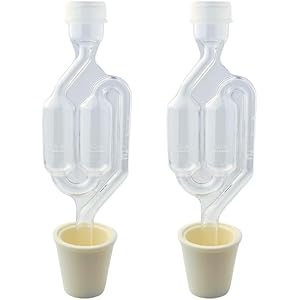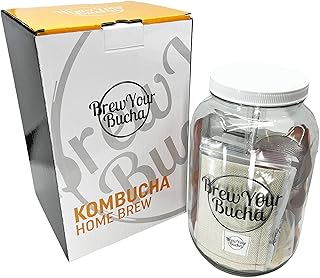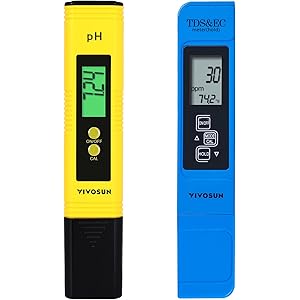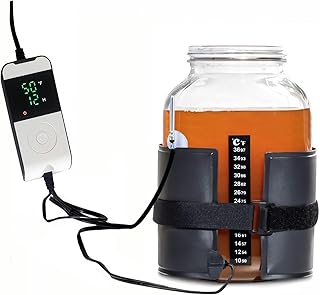Mastering the Second Fermentation of Kombucha with Ginger: A Comprehensive Guide
Kombucha, the effervescent and tangy fermented tea, has taken the beverage world by storm, beloved for its refreshing taste and potential health benefits. While the first fermentation process is essential for creating the base of kombucha, the second fermentation is where the real magic happens, allowing you to add flavors and enhance the fizziness of your brew. In this extensive guide, we’ll explore the ins and outs of the second fermentation of kombucha with ginger, offering tips, tricks, and a step-by-step approach to perfecting your own ginger-infused kombucha.
Understanding Kombucha Fermentation
What is Kombucha?
Kombucha is a fermented tea made by combining brewed tea, sugar, and a symbiotic culture of bacteria and yeast (SCOBY). This process transforms the sweetened tea into a tangy, effervescent drink that is rich in probiotics and beneficial acids. The initial fermentation, known as the primary fermentation, typically lasts 7 to 14 days, during which the SCOBY consumes the sugars and produces various acids and gases.
The Importance of the Second Fermentation
The second fermentation is an optional step that enhances the flavor and carbonation of your kombucha. It occurs after the initial fermentation is complete and allows you to add fruits, herbs, spices, or other flavorings, such as ginger. This stage is critical for achieving that perfect fizzy texture and complex flavor profile that many kombucha enthusiasts crave.
Why Choose Ginger?
Ginger is a popular choice for flavoring kombucha due to its refreshing taste and numerous health benefits. It adds a spicy kick and complements the natural tanginess of kombucha. Ginger is known for its anti-inflammatory properties, digestive support, and potential immune-boosting effects, making it a fantastic addition to your brew.
The Second Fermentation Process
Now that you understand the significance of the second fermentation, let’s dive into the process of infusing your kombucha with ginger.
Step 1: Gather Your Supplies
To begin, you’ll need the following ingredients and equipment:
- Finished Kombucha: After the primary fermentation, your kombucha should taste slightly tangy and less sweet.
- Fresh Ginger: Use organic ginger for the best flavor. You can choose to slice it, grate it, or use ginger juice.
- Flavoring Ingredients (Optional): Feel free to add other ingredients, such as lemon, turmeric, or fruits like berries, for added complexity.
- Bottles: Use glass bottles with tight-fitting caps or swing-top bottles to accommodate the carbonation during the second fermentation.
- Funnel: A funnel makes it easier to pour your kombucha into the bottles without spilling.
- Fine Mesh Strainer (Optional): If you prefer a smoother kombucha without ginger particles, a fine mesh strainer can help.
Step 2: Prepare the Ginger
- Peeling: Start by peeling the ginger root to remove the outer skin. You can use a vegetable peeler or the edge of a spoon.
- Slicing or Grating: Depending on your preference, you can either slice the ginger into thin coins or grate it. Sliced ginger will provide a milder flavor, while grated ginger will infuse a stronger, spicier taste.
- Juicing (Optional): If you prefer a smoother texture, consider juicing the ginger instead. This will provide a concentrated ginger flavor without any fibrous bits.
Step 3: Bottling the Kombucha
- Remove the SCOBY: Carefully take out the SCOBY from the primary fermentation vessel using clean hands. Place it on a clean plate and set it aside for your next batch.
- Strain the Kombucha (Optional): If you want a clear kombucha without any floating particles, pour the kombucha through a fine mesh strainer into a clean bowl or pitcher. This step is optional, as many people enjoy the texture of the ginger in their kombucha.
- Add Ginger to Bottles: Using a funnel, pour the kombucha into your glass bottles, leaving about an inch of headspace at the top. Depending on your preference, add 1 to 2 slices or teaspoons of grated ginger per bottle. If using ginger juice, a tablespoon should suffice.
Step 4: Flavor Variations
The beauty of the second fermentation is the opportunity to experiment with different flavor combinations. Here are a few ideas to inspire you:
- Ginger Lemonade: Add fresh lemon juice or lemon slices along with ginger for a zesty kick.
- Ginger Berry Fusion: Incorporate mixed berries such as strawberries, raspberries, or blueberries for a fruity twist.
- Turmeric Ginger Delight: Combine ginger with fresh turmeric root for an earthy and vibrant flavor.
- Spicy Ginger Mint: Add fresh mint leaves along with ginger for a refreshing herbal note.
Step 5: Carbonation and Secondary Fermentation
- Seal the Bottles: Once you’ve added the ginger and any additional flavorings, securely seal the bottles. This will trap the carbon dioxide produced during fermentation, resulting in a fizzy kombucha.
- Ferment Again: Allow the bottled kombucha to sit at room temperature for 3 to 7 days. The duration depends on your taste preferences and the ambient temperature. Warmer temperatures will speed up fermentation, while cooler ones will slow it down.
- Burp the Bottles: Check your bottles daily by gently releasing the pressure (burping) to prevent over-carbonation. Open the cap slightly and listen for a hiss. If you hear it, it’s a sign that gas is building up. This step is crucial to avoid bottle explosions.
Step 6: Refrigerate and Enjoy
- Refrigeration: Once the kombucha reaches your desired level of fizziness and flavor, transfer the bottles to the refrigerator to halt fermentation. Chilling your kombucha will also enhance its refreshing quality.
- Serve and Enjoy: Pour your ginger-infused kombucha into a glass, savoring the fizzy texture and spicy aroma. You can enjoy it straight or mix it with cocktails, mocktails, or smoothies.
Tips for a Successful Second Fermentation
To ensure a successful second fermentation of your kombucha, keep these tips in mind:
1. Use High-Quality Ingredients
The quality of your tea, sugar, and ginger can significantly impact the final flavor of your kombucha. Opt for organic ingredients whenever possible for the best results.
2. Experiment with Flavor Combinations
Don’t be afraid to experiment with different flavorings in addition to ginger. Try adding other herbs, spices, or fruits to create unique combinations that suit your palate.
3. Monitor Fermentation Time
The length of the second fermentation can vary based on environmental factors and personal taste preferences. Taste your kombucha regularly to find the right balance between sweetness and tartness.
4. Sanitize Equipment
Proper sanitation is key to preventing unwanted bacteria and mold from spoiling your brew. Ensure all your bottles and equipment are clean and free from contaminants.
5. Be Mindful of Carbonation
Excessive carbonation can lead to bottle explosions, so it’s essential to burp your bottles daily and store them in a cool, dark place during fermentation.
6. Store the SCOBY Properly
If you’re not ready to brew another batch right away, store the SCOBY in a small jar with some kombucha to keep it healthy until your next brewing session.
Troubleshooting Common Issues
Even experienced brewers may encounter issues during the second fermentation process. Here are some common problems and their solutions:
1. Flat Kombucha
If your kombucha lacks fizziness, it may be due to insufficient fermentation time or not enough sugar. Ensure that your bottles are tightly sealed and allow more time for fermentation. You can also try adding a bit more sugar or ginger for additional carbonation.
2. Excessive Fizziness
If your kombucha becomes overly fizzy or explodes during the second fermentation, reduce the fermentation time or burp the bottles more frequently to release excess gas.
3. Off-Flavors
If your kombucha develops off-flavors, it may be due to contamination or an imbalanced fermentation process. Make sure to sanitize your equipment thoroughly and monitor the fermentation time to avoid overly sour flavors.
4. Mold Growth
Mold can appear on the surface of your kombucha if proper sanitation practices are not followed. If you notice any fuzzy or discolored spots, discard the batch immediately.
Health Benefits of Ginger-Infused Kombucha
Ginger-infused kombucha combines the benefits of both ginger and probiotics from the fermentation process. Some potential health benefits include:
- Digestive Support: Ginger is known for its ability to aid digestion, relieve bloating, and reduce nausea.
- Anti-Inflammatory Properties: Ginger contains compounds that can help reduce inflammation in the body, making it beneficial for overall health.
- Immune Boosting: The probiotics in kombucha support gut health, while ginger may enhance immune function, providing a double layer of protection against illness.
- Rich in Antioxidants: Both ginger and tea used in kombucha are high in antioxidants, which help combat oxidative stress and may lower the risk of chronic diseases.
- Enhanced Hydration: The effervescent nature of kombucha makes it a refreshing and hydrating beverage, especially when served chilled.
Mastering the second fermentation of kombucha with ginger is a rewarding experience that opens up a world of flavor possibilities. By following the steps outlined in this guide, you can create your own delicious and fizzy ginger kombucha at home. Experiment with different flavor combinations, enjoy the health benefits, and savor the satisfaction of crafting a beverage that is not only enjoyable but also beneficial for your health.
With a little practice, you’ll become a kombucha brewing expert, ready to share your delightful creations with friends and family. So gather your ingredients, get brewing, and immerse yourself in the effervescent world of ginger-infused kombucha!
VIVOSUN Digital pH and TDS Meter Kits, 0.01pH High Accuracy Pen Type pH Meter ± 2% Readout Accuracy 3-in-1 TDS EC Temperature Meter for Hydroponics, Pool and Aquarium, Yellow Blue, UL Certified
$15.99 (as of 02/10/2025 15:41 GMT -03:00 - More infoProduct prices and availability are accurate as of the date/time indicated and are subject to change. Any price and availability information displayed on [relevant Amazon Site(s), as applicable] at the time of purchase will apply to the purchase of this product.)
Receive tips, news and exclusive offers! Sign up for our newsletter now!











